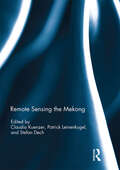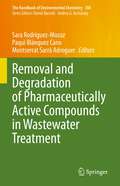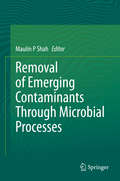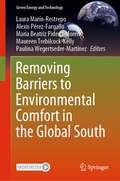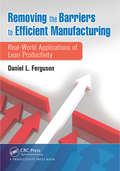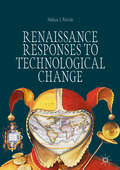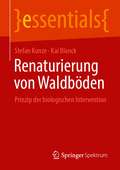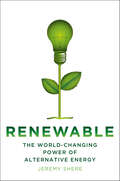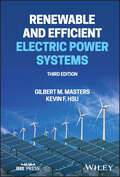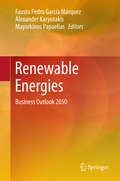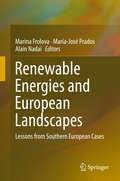- Table View
- List View
Remote Sensing the Mekong
by Claudia Kuenzer Patrick Leinenkugel Stefan DechThe Mekong Basin in Southeast Asia is one of the largest international river basins in the world. Its abundant natural resources are shared by six riparian countries and provide the basis for the livelihoods of more than 75 million people. However, ongoing socio-economic growth and related anthropogenic interventions impact the region’s ecosystems, and there is an urgent need for the monitoring of the basin's land surface dynamics. Remote sensing has evolved as a key tool for this task, allowing for up-to-date analyses and regular monitoring of environmental dynamics beyond physical or political boundaries and at various temporal and spatial scales. This book serves as a forum for remote-sensing scientists with an interest in the Mekong River Basin to present their recent basin-related works as well as applied case studies of the region. A broad range of sensors from high to medium resolution, and from multispectral to SAR systems, are applied, covering topics such as land cover/land use classification and comparison, time series analyses of climate variables, vegetation structure and vegetation productivity, as well as studies on flood mapping or water turbidity monitoring. This book was originally published as a special issue of the International Journal of Remote Sensing.
Remote Sensing Time Series Image Processing (Imaging Science)
by Qihao WengToday, remote sensing technology is an essential tool for understanding the Earth and managing human-Earth interactions. There is a rapidly growing need for remote sensing and Earth observation technology that enables monitoring of world&’s natural resources and environments, managing exposure to natural and man-made risks and more frequently occurring disasters, and helping the sustainability and productivity of natural and human ecosystems. The improvement in temporal resolution/revisit allows for the large accumulation of images for a specific location, creating a possibility for time series image analysis and eventual real-time assessments of scene dynamics. As an authoritative text, Remote Sensing Time Series Image Processing brings together active and recognized authors in the field of time series image analysis and presents to the readers the current state of knowledge and its future directions. Divided into three parts, the first addresses methods and techniques for generating time series image datasets. In particular, it provides guidance on the selection of cloud and cloud shadow detection algorithms for various applications. Part II examines feature development and information extraction methods for time series imagery. It presents some key remote sensing-based metrics, and their major applications in ecosystems and climate change studies. Part III illustrates various applications of time series image processing in land cover change, disturbance attribution, vegetation dynamics, and urbanization. This book is intended for researchers, practitioners, and students in both remote sensing and imaging science. It can be used as a textbook by undergraduate and graduate students majoring in remote sensing, imaging science, civil and electrical engineering, geography, geosciences, planning, environmental science, land use, energy, and GIS, and as a reference book by practitioners and professionals in the government, commercial, and industrial sectors.
Remote Work Revolution: Succeeding from Anywhere
by Tsedal Neeley“I often talk about the importance of trust when it comes to work: the trust of your employees and building trust with your customers. This book provides a blueprint for how to build and maintain that trust and connection in a digital environment.” —Eric S. Yuan, founder and CEO of ZoomA Harvard Business School professor and leading expert in virtual and global work provides remote workers and leaders with the best practices necessary to perform at the highest levels in their organizations. The rapid and unprecedented changes brought on by Covid-19 have accelerated the transition to remote working, requiring the wholesale migration of nearly entire companies to virtual work in just weeks, leaving managers and employees scrambling to adjust. This massive transition has forced companies to rapidly advance their digital footprint, using cloud, storage, cybersecurity, and device tools to accommodate their new remote workforce.Experiencing the benefits of remote working—including nonexistent commute times, lower operational costs, and a larger pool of global job applicants—many companies, including Twitter and Google, plan to permanently incorporate remote days or give employees the option to work from home full-time. But virtual work has it challenges. Employees feel lost, isolated, out of sync, and out of sight. They want to know how to build trust, maintain connections without in-person interactions, and a proper work/life balance. Managers want to know how to lead virtually, how to keep their teams motivated, what digital tools they’ll need, and how to keep employees productive.Providing compelling, evidence-based answers to these and other pressing issues, Remote Work Revolution is essential for navigating the enduring challenges teams and managers face. Filled with specific actionable steps and interactive tools, this timely book will help team members deliver results previously out of reach. Following Neeley’s advice, employees will be able to break through routine norms to successfully use remote work to benefit themselves, their groups, and ultimately their organizations.
Remote Work Technology: Keeping Your Small Business Thriving From Anywhere
by Henry KurkowskiYour small business survival guide for the remote work environment In Remote Work Technology: Keeping Your Small Business Thriving From Anywhere, experienced SaaS and telecommunications entrepreneur Henry Kurkowski delivers a step-by-step walkthrough for using SaaS technology and communication apps to power your small business from anywhere on the planet. You'll learn how to capitalize on the ability to hire a geographically distributed workforce and excel at serving clients at a distance. You'll also discover why and how you need to alter your approach to management and spot the common pitfalls that litter the way to a truly distributed business. This important book includes: Valuable case studies of businesses that embraced the reality of remote working during and after the COVID-19 pandemic and cautionary tales of unexpected challenges that arose during the transition. Discussions of how to incorporate remote workers into efficient workflows to increase your business' productivity Explorations of how to support your employees when you can't just pop into their office Perfect for small business founders, owners, and managers, Remote Work Technology is also a must-read guide for independent contractors who work directly with small businesses and entrepreneurs.
Remotely Piloted Aircraft Systems: A Human Systems Integration Perspective
by Winston Bennett Jr. Nancy J. Cooke Leah J. RoweHighlights the human components of Remotely Piloted Aircraft Systems, their interactions with the technology and each other, and the implications of human capabilities and limitations for the larger system Considers human factors issues associated with RPAS, but within the context of a very large system of people, other vehicles, policy, safety concerns, and varying applications Chapters have been contributed by world class experts in HSI and those with operational RPAS experience Considers unintended consequences associated with taking a more myopic view of this system Examines implications for practice, policy, and research Considers both civil and military aspects of RPAS
Remotely-Sensed Cities
by Victor MesevNew urban applications are emerging for remote sensing, in particular with the use of high-resolution data for measuring, monitoring and analysis. This comes through the use of high spatial resolution imaging, such as for precision mapping of cities; new techniques for population mapping; extracting urban land use features, and evaluating the city
Remotely Sensed Data Characterization, Classification, and Accuracies (Remote Sensing Handbook)
by Prasad S. ThenkabailA volume in the Remote Sensing Handbook series, Remotely Sensed Data Characterization, Classification, and Accuracies documents the scientific and methodological advances that have taken place during the last 50 years. The other two volumes in the series are Land Resources Monitoring, Modeling, and Mapping with Remote Sensing, and Remote Sensing of
Removal and Degradation of Pharmaceutically Active Compounds in Wastewater Treatment (The Handbook of Environmental Chemistry #108)
by Sara Rodriguez-Mozaz Paqui Blánquez Cano Montserrat Sarrà AdroguerThis book reviews water treatment technologies for the removal of pharmaceutically active compounds (PhACs). It provides the reader with an overview of state-of-the-art techniques and recent efforts to develop more sustainable approaches. After nearly two decades of research into the presence and impact of PhACs in the environment, they remain one of the hottest topics in the fields of environmental chemistry, toxicology and engineering. Accordingly, intensive research efforts are currently being devoted to water treatment technologies that can reduce the presence of these emerging contaminants in water bodies. This book examines various types of contaminated water from industry, hospitals and urban wastewater. It provides the reader with a range of potential solutions for water treatment and reuse, and addresses the advancement of analytical tools for evaluating the performance and efficiency of treatment technologies.
Removal of Emerging Contaminants Through Microbial Processes
by Maulin P ShahThe abundance of organic pollutants found in wastewater affect urban surface waters. Traditional wastewater management technologies focus on the removal of suspended solids, nutrients and bacteria, however, new pollutants such as synthetic or naturally occurring chemicals are often not monitored in the environment despite having the potential to enter the environment and cause adverse ecological and human health effects. Collectively referred to as "emerging contaminants," they are mostly derived from domestic activities and occur in trace concentrations ranging from pico to micrograms per liter. Environmental contaminants are resistant to conventional wastewater treatment processes and most of them remain unaffected, causing contamination of receiving water. This in turn leads to the need for advanced wastewater treatment processes capable of removing environmental contaminants to ensure safe fresh water sources. This book provides an up-to-date overview of the current bioremediation strategies, including their limitations, challenges and their potential application to remove environmental pollutants. It also introduces the latest trends and advances in environmental bioremediation, and presents the state-of-the-art in biological and chemical wastewater treatment processes. As such, it will appeal to researchers and policy-makers, as well as undergraduate and graduate environmental sciences students.
Removal of Pollutants from Saline Water: Treatment Technologies
by Shaik FerozRemoval of Pollutants from Saline Water: Treatment Technologies provides a comprehensive understanding of technologies that are currently adopted in the treatment of pollutants present in saline water systems. It provides information on the treatment technologies for saline water systems, including seawater, brackish water, oil-produced water, and other industrial saline wastewaters. FEATURES Presents information exclusively for saline water pollutant removal Introduces current treatment technologies and addresses why and how the techniques differ between fresh and salt water Offers an inclusive overview of physicochemical, biological, membrane, and advanced oxidation treatment technologies Features various perspectives and case studies from relevant global experts Provides a comprehensive one-stop source for the treatment of pollutants in all saline water systems Aimed at students, academicians, researchers, and practicing engineers in the fields of chemical, civil, marine, and environmental engineering who wish to be acquainted with the most recent developments in the treatment of pollutants present in saline water systems. Prof. Dr. Shaik Feroz works at Prince Mohammad Bin Fahd University, Kingdom of Saudi Arabia. He has 30 years of experience in teaching, research, and industry. He has more than 190 publications to his credit in journals and conferences of international repute. He was awarded "Best Researcher" by Caledonian College of Engineering for the year 2014. Prof. Dr. Detlef W. Bahnemann is Head of the Research Unit, Photocatalysis and Nanotechnology at Leibniz University Hannover (Germany), Director of the Research Institute "Nanocomposite Materials for Photonic Applications" at Saint Petersburg State University (Russian Federation), and Distinguished Professor at Shaanxi University of Science and Technology in Xi’an (People's Republic of China). His research topics include photocatalysis, photoelectrochemistry, solar chemistry, and photochemistry focused on synthesis and physical-chemical properties of semiconductor and metal nanoparticles. His 500-plus publications have been cited more than 65,000 times (h-index: 100).
Removal of Refractory Pollutants from Wastewater Treatment Plants
by Maulin P. ShahThis book discusses new and innovative trends and techniques in the removal of toxic and or refractory pollutants through various environmental biotechnological processes from wastewater, both at the laboratory and industrial scale. It focuses primarily on environmentally-friendly technologies which respect the principles of sustainable development, including the advanced trends in remediation through an approach of environmental biotechnological processes from either industrial or sewage wastewater. Features: Examines the fate and occurrence of refractory pollutants in wastewater treatment plants (WWTPs) and the potential approaches for their removal. Highlights advanced remediation procedures involving various microbiological and biochemical processes. Assesses and compares the potential application of numerous existing treatment techniques and introduces new, emerging technologies. Removal of Refractory Pollutants from Wastewater Treatment Plants is suitable for practicing engineers, researchers, water utility managers, and students who seek an excellent introduction and basic knowledge in the principles of environmental bioremediation technologies.
Removing Barriers to Environmental Comfort in the Global South (Green Energy and Technology)
by Laura Marín-Restrepo Alexis Pérez-Fargallo María Beatriz Piderit-Moreno Maureen Trebilcock-Kelly Paulina Wegertseder-MartínezThis book describes how comfort, energy and climate change in developing countries and vulnerable sectors of the population relate to buildings.The building sector is currently facing significant challenges connected to energy consumption, energy poverty and climate change effects. When studied in developing countries and vulnerable sectors of the population, these factors, which are commonplace in the tropics and the southern hemisphere, are interlinked and share a critical component: environmental comfort. Although progress has been made in environmental comfort through research and the development of standards and policies at the international level, in the Global South, where the countries with the highest levels of income inequality are concentrated, environmental comfort has its own characteristics and challenges that prevent a clear understanding from the established vision of the Global North.This book presents research, theories and techniques related to Thermal comfort, Indoor air quality, Visual comfort, and Acoustic comfort and its relationship with energy use and energy efficiency, seeking to address different barriers to environmental comfort. It shows how to improve the way buildings are designed and operated to promote healthier environmental conditions and more sustainable construction, by presenting studies and reflections carried out in the target geographical area: the Global South. In this way, this book contributes to developing the concept of environmental comfort, visualising how progress has been made in understanding it from a tropical and southern perspective, and posing common challenges.The book is intended for engineers, architects, and researchers of the built environment who are interested in environmental comfort and its influence on energy consumption, energy poverty, and other related factors in the Global South context. It is also a useful resource for decision-makers and public policy developers concerned with the indoor comfort of buildings. Moreover, the book aims to provide guidance for those in developing countries by gathering existing knowledge in the field for the tropics and southern hemisphere climatic and sociocultural contexts, allowing us to move forward in this subject with actions and proposed solutions that fit our particular needs.
Removing the Barriers to Efficient Manufacturing: Real-World Applications of Lean Productivity
by Daniel L. FergusonW. Edwards Deming‘s central premise was that improvements in product quality would increase productivity, improve competitive position, and help ensure long-term survival. Point 12 of his landmark 14 Points for Management says that management‘s job is to remove the barriers that keep people from taking pride in their work. That‘s exactly what this book is about.Shedding new light on Deming‘s 14 Points, Removing the Barriers to Efficient Manufacturing: Real-World Applications of Lean Productivity outlines time-tested organizational structures and methods to help you reduce variability and deliver high-quality products consistently. It describes the financial losses that can occur as a result of variability and details the specific activities management must engage in to avoid these losses and ensure long-term success.Instead of taking you on a random walk, the book supplies each manufacturing group in your organization with straightforward directions for creating a smooth-running facility with reduced variability. It includes work assignments in each chapter that, if completed in the order presented, will guide you through the creation of the Model Vision for your manufacturing facility. It also:Covers key topics on working with people, including training and retrainingSupplies pointers for working with unions Considers Single Minute Exchange of Die (SMED)Describes how to put it all together with action plansThe book includes a write up on Deming‘s famous Red Bead Experiment as well as an introduction to statistical process control techniques in the appendices. Filled with real-world examples and a case study to illustrate essential concepts, the book arms you with the insight and common-sense approaches required to build on Deming‘s fundamental principles and consistently deliver high-quality pr
Remya Jose's Great Idea (Fountas & Pinnell LLI Red #Level L)
by Sunita ApteMEET REMYA JOSE, TEEN MENTOR For Remya, a busy 14-year-old, there just weren't enough hours in the day. Lots of teens face the same problem. But how many solve it with a new invention?
The Renaissance of Renewable Energy
by Gian Andrea Pagnoni Stephen RocheThis book provides detailed yet easily understandable information about sustainable energy alternatives in the context of growing public concern about climate change, the impending fuel crisis and environmental degradation. It deals with the history of energy use and the factors that have led to the current interest in energy alternatives and assesses the chance of renewable energy replacing fossil fuels in the future. The authors manage to make a highly complex and often intimidating subject not only accessible but also engaging and entertaining. This book unpacks but never simplifies the science of energy, leavening the more technical passages with anecdotes, metaphors, examples and imagery. By also dealing with the history, politics and economics of energy use, it offers both scientific and non-scientific readers a deeper understanding of the most important issue of our age.
Renaissance Responses to Technological Change
by Sheila J. NayarThis book foregrounds the pressures that three transformative technologies in the long sixteenth century—the printing press, gunpowder, and the magnetic compass—placed on long-held literary practices, as well as on cultural and social structures. Sheila J. Nayar disinters the clash between humanist drives and print culture; places the rise of gunpowder warfare beside the equivalent rise in chivalric romance; and illustrates fraught attempts by humanists to hold on to classicist traditions in the face of seismic changes in navigation. Lively and engaging, this study illuminates not only how literature responded to radical technological changes, but also how literature was sometimes forced, through unanticipated destabilizations, to reimagine itself. By tracing the early modern human’s inter-animation with print, powder, and compass, Nayar exposes how these technologies assisted in producing new ways of seeing, knowing, and being in the world.
Renaturierung von Waldböden: Prinzip der biologischen Intervention (essentials)
by Stefan Kunze Kai BlanckDas Buch zeigt Wege, Wälder gegen Trockenheit und Klimawandel zu stabilisieren. Der Waldboden muss dazu viel stärker beachtet und durch biologische Maßnahmen gestärkt werden. Gerade auf sauren, nährstoffarmen Standorten, wo Fichten und Kiefern in Monokulturen wachsen, führt das punktuelle Einbringen von Biokompost zum Rückgang der Versauerung und damit zur Revitalisierung von Boden und Pflanzen. Die über Jahre erprobte „Biologische Intervention“ gibt den Bäumen neue Kraft, die sie zukünftig brauchen. Die Humusanreicherung bringt mehr Leben in den Boden. Nur ein gesunder Boden kann gesunde Bäume tragen.
Renewable: The World-Changing Power of Alternative Energy
by Jeremy ShereWhere does the energy we use come from? It's absolutely vital to every single thing we do every day, but for most people, it is utterly invisible. Flick a switch and the lights go on. It might as well be magic. Science writer Jeremy Shere shows us in Renewable: The World-Changing Powerof Alternative Energy that energy is anything but magical. Producing it in fossil fuel form is a dirty, expensive—but also hugely profitable— enterprise, with enormous but largely hidden costs to the entire planet. The cold, hard fact is that at some point we will have wrung the planet dry of easily accessible sources of fossil fuel. And when that time comes, humankind will have no choice but to turn—or, more accurately, return—to other, cleaner, renewable energy sources. What will those sources be? How far have we come to realizing the technologies that will make these sources available?To find the answers, Shere began his journey with a tour of a traditional coal-fueled power plant in his home state of Indiana. He then continued on, traveling from coast to coast as he spoke to scientists, scholars and innovators. He immersed himself in the green energy world: visiting a solar farm at Denver's airport, attending the Wind Power Expo and a wind farm tour in Texas, investigating turbines deep in New York City's East River, and much more. Arranged in five parts—Green Gas, Sun, Wind, Earth, and Water—Renewable tells the stories of the most interesting and promising types of renewable energy: namely, biofuel, solar, wind, geothermal, and hydropower. But unlike many books about alternative energy, Renewable is not obsessed with megawatts and tips for building home solar panels. Instead, Shere digs into the rich, surprisingly long histories of these technologies, bringing to life the pioneering scientists, inventors, and visionaries who blazed the way for solar, wind, hydro, and other forms of renewable power, and unearthing the curious involvement of great thinkers like Henry Ford, Thomas Edison, and Nicola Tesla.We are at an important crossroads in the history of renewable technologies. The possibilities are endless and enticing, and it has become increasingly clear that renewable energy is the way of the future. In Renewable, Jeremy Shere's natural curiosity and serious research come together in an entertaining and informative guide to where renewable energy has been, where it is today, and where it's heading.
Renewable and Efficient Electric Power Systems
by Gilbert M. MastersA solid, quantitative, practical introduction to a wide range of renewable energy systems-in a completely updated, new edition The second edition of Renewable and Efficient Electric Power Systems provides a solid, quantitative, practical introduction to a wide range of renewable energy systems. For each topic, essential theoretical background is introduced, practical engineering considerations associated with designing systems and predicting their performance are provided, and methods for evaluating the economics of these systems are presented. While the book focuses on the fastest growing, most promising wind and solar technologies, new material on tidal and wave power, small-scale hydroelectric power, geothermal and biomass systems is introduced. Both supply-side and demand-side technologies are blended in the final chapter, which introduces the emerging smart grid. As the fraction of our power generated by renewable resources increases, the role of demand-side management in helping maintain grid balance is explored. Renewable energy systems have become mainstream technologies and are now, literally, big business. Throughout this edition, more depth has been provided on the financial analysis of large-scale conventional and renewable energy projects. While grid-connected systems dominate the market today, off-grid systems are beginning to have a significant impact on emerging economies where electricity is a scarce commodity. Considerable attention is paid to the economics of all of these systems. This edition has been completely rewritten, updated, and reorganized. New material has been presented both in the form of new topics as well as in greater depth in some areas. The section on the fundamentals of electric power has been enhanced, making this edition a much better bridge to the more advanced courses in power that are returning to many electrical engineering programs. This includes an introduction to phasor notation, more emphasis on reactive power as well as real power, more on power converter and inverter electronics, and more material on generator technologies. Realizing that many students, as well as professionals, in this increasingly important field may have modest electrical engineering backgrounds, early chapters develop the skills and knowledge necessary to understand these important topics without the need for supplementary materials. With numerous completely worked examples throughout, the book has been designed to encourage self-instruction. The book includes worked examples for virtually every topic that lends itself to quantitative analysis. Each chapter ends with a problem set that provides additional practice. This is an essential resource for a mixed audience of engineering and other technology-focused individuals.
Renewable and Efficient Electric Power Systems (Ieee Press Ser.)
by Gilbert M. Masters Kevin F. HsuRENEWABLE AND EFFICIENT ELECTRIC POWER SYSTEMS Join the energy revolution—this comprehensive resource offers quantitative and practical approaches for designing a sustainable, 21st-century electricity system, covering renewable generation technologies, conventional power plants, energy efficiency, storage, and microgrids. Renewable and Efficient Electric Power Systems dives into the fundamentals of modern electricity systems, introducing key technologies, economic and environmental impacts, and practical considerations for energy and climate professionals. The book explains the science and engineering underlying renewable energy—including solar, wind, and hydropower—along with an expanded set of key energy technologies such as fuel cells, batteries, and hydrogen. This updated edition prepares readers to participate in the world’s ongoing efforts to decarbonize the electricity sector and move toward a more sustainable future. The book covers foundational knowledge of electric power, up through current developments and future prospects for renewable energy. The update significantly expands core content to address topics such as energy efficiency, smart grids, energy storage, and microgrids. It reframes energy as an integral factor in urban development and highlights forward-looking strategies to decarbonize the built environment. The text draws on a multi-scalar approach that ranges from utility-scale to building-scale to assess energy systems, and further considers centralized vs. distributed system architecture. The authors integrate perspectives from engineering professionals across different sectors, incorporating relevant insights from applied projects, with an eye toward implementing energy systems in the real world. Given the textbook’s broad reach, this edition situates energy development in an international context and provides examples relevant to a global audience. An essential resource for engineers and other practitioners working in climate and energy, offering cutting-edge frameworks and quantitative approaches to energy system design. Early chapters develop the skills and knowledge necessary for students and professionals entering the clean energy field. Later chapters offer an excellent bridge to prepare advanced students for further study in power engineering, or who intend to pursue policy or economic analysis. Step-by-step explanations of quantitative analysis are supplemented with additional practice problems to encourage self-instruction or complement classroom use. Accessible explanations provide planners and policymakers with fundamental technical understanding of energy systems. Combines pure technical analysis with economic and environmental considerations, and explores the link between energy, carbon, and new digital technologies, to provide a more comprehensive approach to energy education. As the world undergoes a transformation in energy and electricity, Renewable and Efficient Electric Power Systems is an indispensable text for students of energy, environment, and climate, as well as for practitioners seeking to refresh their understanding of renewable energy systems.
Renewable and Sustainable Materials in Green Technology (SpringerBriefs in Applied Sciences and Technology)
by Mohd Firdaus Yhaya Husnul Azan Tajarudin Mardiana Idayu AhmadThis book discusses recent developments in renewable and sustainable materials from a green technology perspective and how these materials interact with the environment. It highlights the fundamental processes involved in the production of renewable and sustainable materials, including chemical and biological approaches as well as these materials’ potential application as green technological option. Written in a didactic style, it offers a guide and insights into renewable and sustainable materials. Each chapter provides in-depth technical information on the material’s theory and its applications. The book shows how new materials may help us solve human and environmental issues in the future and suggests where current research may lead.
Renewable Biofuels
by Diwakar Rana Vandana RanaThis book offers a complete introduction for novices to understand key concepts of biocatalysis and how to produce in-house enzymes that can be used for low-cost biofuels production. The authors discuss the challenges involved in the commercialization of the biofuel industry, given the expense of commercial enzymes used for lignocellulose conversion. They describe the limitations in the process, such as complexity of lignocellulose structure, different microbial communities' actions and interactions for degrading the recalcitrant structure of lignocellulosic materials, hydrolysis mechanism and potential for bio refinery. Readers will gain understanding of the key concepts of microbial catalysis of lignocellulosic biomass, process complexities and selection of microbes for catalysis or genetic engineering to improve the production of bioethanol or biofuel
Renewable Electricity and the Grid: The Challenge of Variability
by Godfrey Boyle?Integrating intermittent renewable energy sources like wind into electricity systems must be one of the most misunderstood issues in energy policy. This edited volume brings together a unique series of authoritative articles on the topic. There should be no excuse for misunderstanding from now on.? JIM SKEA, RESEARCH DIRECTOR, UK ENERGY RESEARCH CENTRE ?The future design and operation of electric power systems with large injections of renewable energy generation is the subject of much debate, and some misunderstanding. This timely book, from a number of authors with expertise in the area, makes an important contribution to our understanding of this topic.? NICK JENKINS, PROFESSOR OF ENERGY SYSTEMS, UNIVERSITY OF MANCHESTER ?We know the future will be different from the past. This book predicts how large proportions of renewable energy can be incorporated into electricity grids, without harm from the natural variability of these supplies. The chapter authors have different approaches and vision, yet the overall message is positive. Not only can we move to dominant use of renewable electricity, but we can do so utilizing many technological and efficiency improvements, with consumers benefiting from clean electricity at acceptable cost.? PROFESSOR JOHN TWIDELL, GENERAL EDITOR, WIND ENGINEERING 'Anyone interested in renewable electricity will find this book an important reference. It answers many of teh questions so often raised in public debates' Sherkin Comment Can renewable energy provide reliable power? Will it need extensive backup? The energy available from wind, waves, tides and the sun varies in ways that may not match variations in energy demand. Assimilating these fluctuations can affect the operation and economics of electricity networks, markets and the output of other forms of generation. Is this a significant problem, or can these new sources be integrated into the grid system without the need for extensive backup or energy storage capacity? This book examines the significance of the issue of variability of renewable electricity supplies, and presents technical and operational solutions to the problem of reconciling the differing patterns of supply and demand. Its chapters are authored by leading experts in the field, who aim to explain and quantify the impacts of variability in renewable energy, and in doing so, dispel many of the myths and misunderstandings surrounding the topic.
Renewable Energies
by Fausto Pedro García Márquez Alexander Karyotakis Mayorkinos PapaeliasThis book provides a comprehensive overview of current renewable energy technologies and their basic principles. It also addresses the financial aspects of renewable energy projects and analyzes their profitability, covering the most relevant topics for engineers, economists, managers and scientists who are actively involved in renewable energy research and management. The authors are professionals and researchers who are active in the industry, and supplement the main content with revealing case studies and best-practice examples.
Renewable Energies and European Landscapes
by Marina Frolova María-José Prados Alain NadaïThis book provides timely, multidisciplinary cross-national comparison of the institutional and social processes through which renewable energy landscapes have emerged in Southern Europe. On the basis of case studies in these countries, it analyzes the way in which and the extent to which the development of renewable energies has affected landscape forms and whether or not it has contributed to a reformulation of landscape practices and values in these countries. Landscape is conceived broadly, as a material, social, political and historical process embedded into the local realm, going beyond aesthetic. The case studies analyze renewable energy landscapes in Southern Europe on different political and geographical scales and compare different types of renewable energy such as wind, hydro, solar and biomass power. The contributors are leading experts from Spain, France, Italy and Portugal. The book is intended for researchers, graduate students and professionals interested in geography, landscape and planning.
